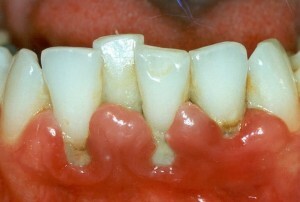 Catarrhal gingivitis is an inflammation of the gingival mucosa. As a rule, this disease occurs in children and people of young age( under 35 years).In adults, the catarrhal form of gingivitis has a prolonged course. This form of the disease occurs in 90% of all cases of gingivitis. All inflammatory processes occur in the peri-toothed tissues, without affecting the bone tissue.
Catarrhal gingivitis is an inflammation of the gingival mucosa. As a rule, this disease occurs in children and people of young age( under 35 years).In adults, the catarrhal form of gingivitis has a prolonged course. This form of the disease occurs in 90% of all cases of gingivitis. All inflammatory processes occur in the peri-toothed tissues, without affecting the bone tissue.
Endemic changes are manifested by edema, overflow of the pituitary gingiva and hemophilia of the gingival margin. The monolithicity of the tooth-gingival fusion is not disturbed, but because of the swelling the size of the interdental papillae increases and there is a feeling of penetration of the gingival sulcus.
Contents
Provoking factors - a lot of
All the causes that can trigger the development of the disease can be divided into four groups:
- Local .They are included in the poor hygiene of the oral cavity, which results in bacterial plaque and soft tissue defectiveness( shortened bridles of the tongue and lips), as well as in improper prosthetics and tooth filling. Also, local factors include the formation of teeth on the teeth and the wrong occlusion.
- Local - traumas of teeth( displacement, dislocation, fracture, etc.), abnormality of teeth, cervical caries, defects in delivered samples.
- General - diseases of the digestive system( gastritis, ulcer), hormonal disorders, stress, blood diseases, improper work of the endocrine and cardiovascular system, the presence of allergic and infectious diseases and hypovitaminosis. Also, the common causes of the onset of the disease include the onset of certain physiological periods of life: pregnancy, menopause and pubertal age.
- System - wrong structure of the jaw( teeth at the same time have a close arrangement), the period of teething( in children).
The most important factor that provokes the development of the catarrhal form of gingivitis is a dental plaque, in which 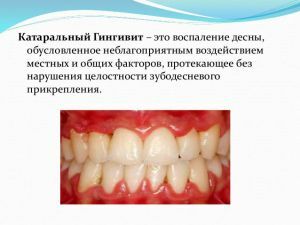 contains such microorganisms as: staphylococci, streptococci, fusobacteria, treponema and porphyromonades.
contains such microorganisms as: staphylococci, streptococci, fusobacteria, treponema and porphyromonades.
All these microorganisms produce toxic substances, resulting in inflammatory reactions in the damaged gum. Inflammation migrates from small areas to the entire gum area, including its fixed part. In general, the degree of damage to the dental system by this bacterial accumulation is due to the state of the immune system and the body's defenses.
Forms and stages
Based on the nature of the lesion, catarrhal gingivitis is divided into two forms:
- Chronic .Appears as a result of untimely therapy of acute disease. The disease proceeds very slowly, without a special manifestation of the characteristic clinical picture. During the course of the disease, periodic exacerbations do not occur. The prolonged form of the disease requires iterative therapy.
- Acute .This form is manifested by a rapidly progressive inflammation of the gingival tissue, which has a temporary character. It occurs due to intoxication of the body or a previously transmitted virus disease( acute respiratory disease or influenza).
In terms of severity, the disease has three stages of percolation:
- , the easy stage of , is manifested by damage to the dentogingival papillae;
- middle stage - inflammation of the empty gum area( marginal gums);
- severe stage - the developed inflammation grasps the alveolar region of the gum.
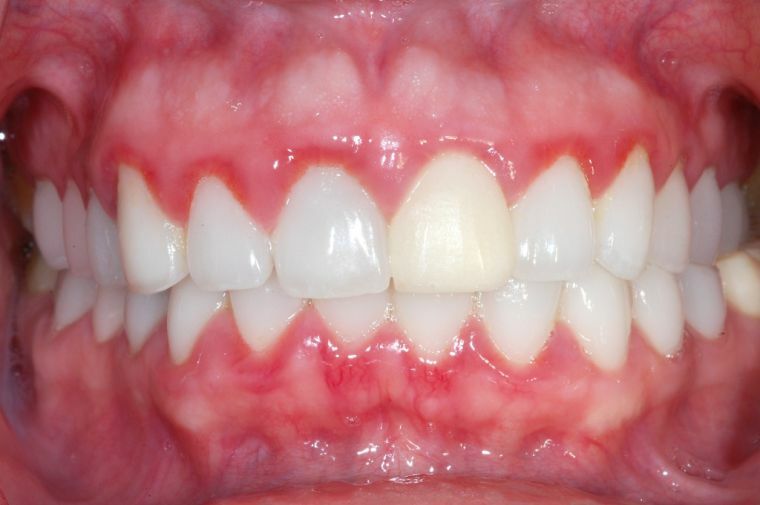
On the scale of the lesion, the disease is divided into two forms:
- Localized .With this form, a small part of the teeth is affected - 1-3 teeth.
- Generalized .The gums become inflamed all along the perimeter of one or both jaws.
Clinic and Symptoms
With catarrhal gingivitis, there are common symptoms in the form of unpleasant sensations and hemophilia in the gums, itching, perversion of taste and unpleasant odor.
In acute forms of pain, the pain increases during the meal. This is due to the effect on the gums of chemical, or mechanical stimuli. The general condition of the patients is satisfactory, but with the onset of an exacerbation, subfebrile temperature and malaise may appear.
Chronic catarrhal gingivitis occurs for a long time and is practically asymptomatic. Inflammation, as a rule, extends only to the interdental papillae and marginal gingiva. In the process of objective diagnosis, cyanosis, blood overflow, edema, thickening of the gingiva, erosion in the region of the tips of the interdental papilla are noted.
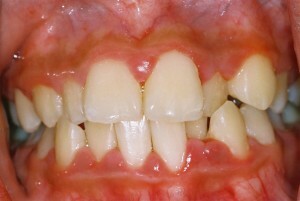 In some cases, because of the swelling of the gums, periodontal pockets may appear. But this happens only when the integrity of the dentogingival joint is disturbed. A large amount of soft plaque occurs behind the teeth. It is also possible the appearance of a solid colored plaque in the cervical region. Bone tissue, as a rule, remains unchanged.
In some cases, because of the swelling of the gums, periodontal pockets may appear. But this happens only when the integrity of the dentogingival joint is disturbed. A large amount of soft plaque occurs behind the teeth. It is also possible the appearance of a solid colored plaque in the cervical region. Bone tissue, as a rule, remains unchanged.
Acute catarrhal gingivitis is most common in children. With a visual examination of the gums, the color changes to a bright red color with an inherent swelling. When palpating the affected area, blood may protrude. Deposits are observed in the oral cavity. Soft fabrics have a cyanotic color.
Diagnostic criteria and methods
Doctors say that diagnosing the disease can only be done with certain hardware studies and special tests. Inflammation can be determined with the help of such tests:
- hygiene index according to Fedorov-Volodina - the indicator should be greater than one;
- PMA index - also should be more than one;
- sample Kulazhenko - allows to determine the site of development of hematoma;
- test of Schiller-Pisarev - the result should be positive.
In addition to the above tests, the following tests are performed to diagnose catarrhal gingivitis:
- Visual inspection of .Diagnosis is performed on the basis of the clinical manifestation and characteristic symptoms.
- Conducting reoparodontography and Doppler flowmetry .These methods of research allow us to evaluate microcirculation in periodontal tissues.
- Carry out the analysis of quantitative and qualitative composition of the gingival fluid .Thus, the presence of inflammation and changes in the structure of the gums are determined.
- Probing of the gingival pockets .The pathology of mobility of teeth is determined.
- X-ray .This method is used to determine the monolithic bone tissue of immovable processes.
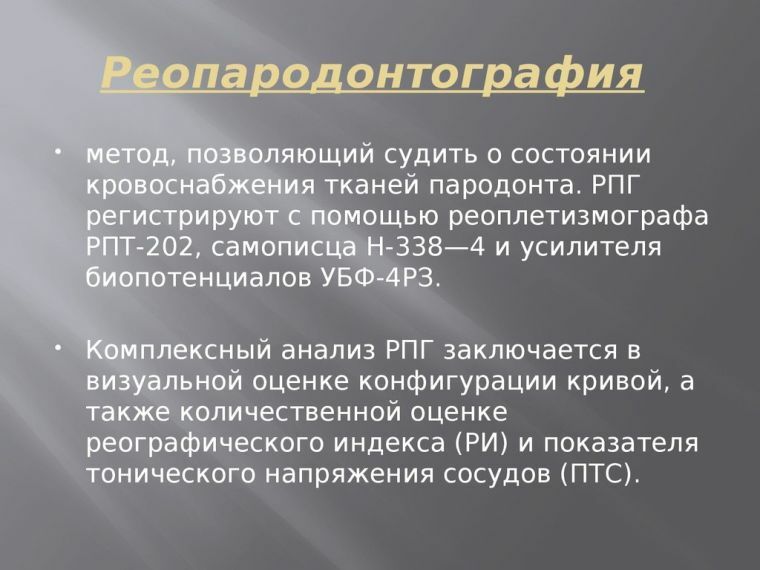
To determine the form of the course of the disease and the choice of method of treatment, a general blood test is assigned.
Medical care
Treatment of catarrhal gingivitis is to eliminate the internal causes of the disease that contributed to its development. During the therapy, all painful sensations are removed, edema is removed and the development of other infections is prevented.
Initially, it is necessary to remove all available dental deposits( plaque and stone).This is done with the help of special  dental equipment.
dental equipment.
Various chemical and medicinal compounds can be used to remove deposits. If the patient has seals and dentures, they must be replaced with new ones and correct bite( if it was wrong).Purified teeth are ground and covered with special compositions containing fluoride.
In the treatment of gingivitis, medicament tablets are not always used. Most often, patients are prescribed careful oral hygiene and rinsing the mouth with a solution of Chlorhexidine. But before this, you still need to remove plaque.
To restore periodontal, vitamin A, sea buckthorn oil and Cristaline cream are prescribed. With regular hygiene and absence of traumatic factors( malocclusion, etc.), doctors recommend performing physiotherapeutic procedures:
- using electrophoresis;
- application of helium-nylon laser, which promotes rapid removal of inflammation;
- application of phonophoresis, which helps to improve microcirculation and stop the inflammatory process.
 More recently, a new method for treating catarrhal gingivitis has been introduced, which consists in the injection of platelet autoplasm. This method of therapy is called plasmolifting. With this procedure, the clinical picture is improving in the second week of treatment. After the third month of treatment, prolonged efficacy is noted.
More recently, a new method for treating catarrhal gingivitis has been introduced, which consists in the injection of platelet autoplasm. This method of therapy is called plasmolifting. With this procedure, the clinical picture is improving in the second week of treatment. After the third month of treatment, prolonged efficacy is noted.
In particularly difficult situations, gingivectomy is used - surgical intervention on the gums.
Consequences and preventive measures
Doctors predict a favorable outcome of the disease only if a timely diagnosis of the disease was made.
Untimely therapy increases the risk of chronic forms of catarrhal gingivitis. Sometimes, against the background of this disease, there is periodontitis and ulcerative necrotic gingivitis.
In the absence of effective treatment, the risk of developing loosening of the teeth increases. There is also a risk of an inflammatory process leading to diseases such as gum abscess or the jawbone.
Prevention of the disease primarily consists in correct and thorough oral hygiene, namely:
- regular cleaning of teeth from plaque;
- systematic examination with a dentist;
- rinsing the oral cavity with antiseptic;
- use of dental floss;
- protection of the mouth from injury.
A dentist should help you choose the right personal care products: toothbrush and toothpaste, mouthwashes and floss. For prevention, doctors recommend every day to remove dental plaques and visit the dentist regularly( every six months).
